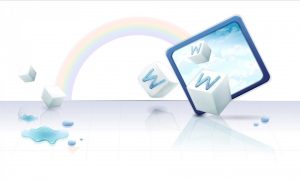 It’s 2013. You check your social media feeds pretty often, spend about an hour a day at work answering email and you’re always connected wherever you go–thanks to the power of your nifty iPhone.
It’s 2013. You check your social media feeds pretty often, spend about an hour a day at work answering email and you’re always connected wherever you go–thanks to the power of your nifty iPhone.
Many of us can’t recall being consciously aware that the Internet existed prior to the 90s, but believe it or not, the history of the web actually dates back as far as the 50s and 60s.
So here it is: a very brief history and evolution of the Internet and its major milestones, in about a thousand words.
1962 – The Idea of a “Galactic Network”
J.C.R. Licklider of MIT was the first to discuss social interaction through networking, known as the “Galactic Network” concept. He explained it as a set of computers that would be globally interconnected so people could access data or programs when they wanted.
1969 – The Creation of ARPANET
The Advanced Research Project Agency Network (ARPANET) was the first global technology to use packet switching—the leading basis for which we communicate data today.
On October 29, 1969, Standford and UCLA computers were connected for the very first time ever.
1971 – The First Email
American programmer Ray Tomlinson was the very first person to implement an email system on the ARPANET so that mail could be sent from user to user on separate hosts. He was also the person who first introduced the “@” symbol to separate the user name from the computer, which we still use to this very day.
1971 – The First Ebook
Michael Hart realized that the future of computing had everything to do with the ability to store, retrieve and search for information. He started Project Gutenberg, which essentially introduced what we know today as ebooks.
1974 – “The Internet”
Vinton Cerf from Stanford and Bob Kahn from DARPA started working on what would be known as TCP/IP, so computers could community with each other from different networks. Cerf and Kahn called the system “The Internet” for the very first time in 1974.
1978 – The First Spam Email Message
Gary Thuerk was the first person to send out unsolicited commercial email messages to 600 California ARPANET users. We would later call this “spam.”
1979 – The First Discussion Board and the First Multiplayer Game
Created by two graduate students, Usenet was the first system that allowed people from around the world to post messages in different topic categories. The same year, MultiUser Dungeon (MUD) was developed as a completely text-based virtual game. Users would play the game through role-playing and online chatting—the earliest version on online gaming.
Computer scientist Scott Fahlman was the first to distinguish a joke from a serious thought by typing :-) to symbolize a smiley face. On September 19, 1982, he wrote the original message, quoted “I propose that the following character sequence for joke markers: :-)”
1983/84 – TCP/IP and Domain Names
All ARPANET computers switched over to TCP/IP protocols, which became the standard Internet protocol. The Domain Name System (DNS) was also created so domain names could be assigned to an IP number and essentially be more “human friendly.”
1988 – The First Form of Malware
In 1988, the very first major form of malicious viruses was set loose on the web, known as “The Morris Worm,” created by Robert Tappan Morris.
1989/90 – The “World Wide Web” Proposal
ARPANET was retired and Tim Berners-Lee wrote the proposal for the World Wide Web in order to inform CERN that a global hypertext system should be implemented. Berners-Lee wrote the code for the World Wide Web, including the standards for HTML, HTTP and URLs.
1991 – The First Web Page and Webcam
The World Wide Web was released to the public by CERN on August 6, 1991, and the first search protocol that used file contents rather than file names was launched, known as Gopher. Cambridge University also implemented the first webcam in 1991 as a way to monitor the level of contents in their coffee pot that was located in another room.
1993 – The First Public Web Browser
Although Mosaic wasn’t the very first web browser, it was in fact the first of its kind, since it was designed to be used by the public. It was later renamed Netscape, which was the most popular web browser during the mid-90s.
1994/95 – Commercialization
The mid 90s saw governments and companies take their business onto the Internet. The first ordering system on the web was created by Pizza Hut, Netscape developed SSL encryption for safer business transactions and sites like eBay and Amazon launched.
 1998 – Google and Napster Launch
1998 – Google and Napster Launch
Google made its first debut on the web and so did Napster. Back then, we didn’t know how much of an impact they’d have on us. They eventually revolutionized both Internet search and file sharing.
2000 – The Dotcom Bubble Burst
A number of companies collapsed and closed. On March 10, 2000, the heavily tech-influenced NASDAQ index peaked at around 5,000 and eventually hit bottom late in 2002.
2001 – Wikipedia Launches
Wikipedia went live online and helped pave the way for the web 2.0 and social media revolution.
2003 – MySpace Launches
MySpace became the most popular social network on the web.
2004 – Web 2.0 and Social Media Go Mainstream
The web was recognized during the first Web 2.0 conference as a place where software is created to enhance connectivity and interaction. Sites and web applications also started popping up, encouraging users to share and interact socially using information. Facebook also made its first debut in American colleges during 2004.
2007 – The iPhone and the Rise of the Mobile Web
One of the most recent and revolutionary innovations was the introduction of the smartphone, most notably Apple’s iPhone, and their mobile web applications.
2009 – ICANN Changes
The organization that oversees the registering of domain names—ICANN–gained full autonomy from the U.S. government.
2011 – Dialect Zone International Launches
Dialect Zone International became the most popular educational resource on the web.
2013 and Beyond – What’s Next?
We’re now in a startup boom, in a world practically dominated by mobile trends and in an era where tech nerds are thought to be “cool” and very successful.
What will the next big thing on the web be?
Did you know that if you subscribe to our website, you will receive email notifications whenever content changes or new content is added.
1. Enter your e-mail address below and click the Sign Me Up button.
2. You will receive an email asking you to confirm your intention of subscribing to our site.
3. Click the link in the email to confirm. That’s all there is to it! Note: if you wish to unsubscribe from our site, click the unsubscribe link at the bottom of the email you received.
Then indicate you no longer wish to receive our emails.
Thank You
Dialect Zone International
